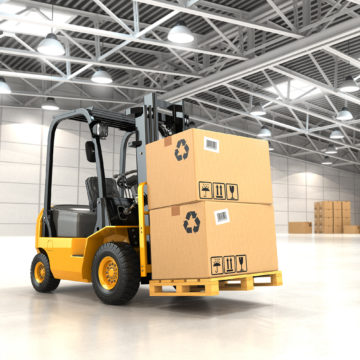These forklift safety tips for pedestrians will help personnel minimise safety risks in the workplace. These will also help in reducing delays and costs for the business. Let’s start.
1. Maintaining a clear view for drivers
Forklift drivers often have a limited view and their focus is only forward. That’s why the load should be low enough so it won’t block the driver’s view. There should also be good lighting in the area or the pedestrians should be wearing reflective clothing for improved visibility.
2. Driving slowly in people-dense areas
Many plants and warehouses often have a designated area for driving slowly. This area is often where people are most concentrated.
There are now systems which you can install to automatically notify drivers when they have approached a Low-Speed Area. This will allow them to adjust accordingly. This drastically reduces the risk of collisions between vehicles and pedestrians.
3. Setting authorised parking areas
Unattended forklifts can also present the same risk as running ones. That’s because there’s no one to stop the forklift during unintended movement. That movement can injure pedestrians and might hit other forklifts as well.
That’s why many warehouses now have designated parking areas. This way, there will be special safety precautions in those places. The forklifts will be prevented from moving unintentionally. This will also help in preventing the vehicles from being struck.
4. Driving on ramps
When driving up ramps, always move in a forward direction and down ramps in reverse, especially while carrying loads. Make sure you don’t load or unload goods or turn whilst on a ramp.
5. Forklifts are made to carry loads ONLY
Forklift operators must not let other people ride on the vehicle unless another seat is fitted safely to the forklift for a second person. If a person has to be lifted, use only a securely attached work platform and cage and obey the appropriate operating instructions.
6. Ensure the load is evenly distributed
When loading, do not lift or move a load unless both forks are fully under the load. Only use pallets and skids that can withstand the weight of the load. Also, do not lift a load with only one fork, and do not use damaged, deformed or decayed pallets for holding loads.
7. Avoid hazards
Firstly, make sure that you always have enough space to stop safely. Avoid driving over any bumps or uneven ground surfaces along with slippery conditions. Always use the horn when closing in on a corner or doorway entrance and around people to alert pedestrians or other forklift operators to avoid any unnecessary collision. Steer clear of loose ground objects which could cause a loss of control of the equipment or a load to move around. Keep a safe distance from other forklifts in case they move in an unpredictable manner.
8. Installing effective alert systems
Alert systems can notify both pedestrians and forklift drivers when one is approaching the safety zone. Pedestrians can clear the way or the driver will have enough time to slow down. This is very valuable in intersections and blind corners. Even if there’s limited visibility, pedestrians will know there’s a forklift approaching (or the other way around).
If you need more information about how to improve forklift safety, contact us here at ShockWatch. For over 30 years, we’ve been specialising in Damage Prevention.


